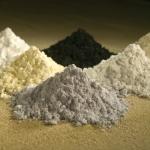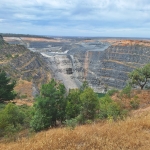CANADA: Sudden Wealth's High Price
Canada's booming oil sands operations hard on environment
Huge mines here turning tarry sand into cash for Canada and oil for the United States are taking an unexpectedly high environmental toll, sucking water from rivers and natural gas from wells and producing large amounts of gases linked to global warming.
The digging has proliferated at gold-rush speed, spurred by high oil prices, new technology and an unquenched U.S. thirst for the fuel. The expansion has presented ecological problems that experts thought they would have decades to resolve.
"The river used to be blue. Now it's brown. Nobody can fish or drink from it. The air is bad. This has all happened so fast," said Elsie Fabian, 63, an elder in a native Indian community along the Athabasca River, a wide, meandering waterway once plied by fur traders. "It's terrible. We're surrounded by the mines."
From her home on the bluff of the river, she can see billowing steam rising from a vast strip mine 10 miles away. There, almost 200 feet below what was once a forest, giant machines cleave the earth into a cratered moonscape. Trucks the size of houses prowl the pit. They deliver the black soil to clanking conveyers and vats that steam the tar from the sand.
High environmental cost
The miners have created a marvel of human industry that takes a spongy muck once considered worthless and converts it into oil for gasoline, diesel and jet fuel. But the price of that alchemy is high: Each barrel of oil requires two to five barrels of water, carves up 4 tons of earth and uses enough natural gas to heat a home for one to five days, according to the industry's own calculations.
"The environmental cost has been great," said Jim Boucher, chief of the Ft. McKay First Nations Council, which includes Cree and Dene Indians, 35 miles north of Ft. McMurray. He grew up on land that is now a clawed-out mine pit. But he has led his people into the mines by creating native-owned companies providing catering, truck driving, surveying and other services.
"There is no other economic option," he said. "Hunting, trapping, fishing are gone."
Operators of the mines, which have helped make Canada the largest supplier of oil to the United States, believe they can find technological solutions to the environmental problems.
"There is a whole lot of work being done," Charles Ruigrok, chief executive of Syncrude, one of the largest companies, said at his corporate headquarters in Ft. McMurray. "I do believe technology will fix it."
The oil companies point to steady reductions in the amount of water and natural gas used to produce each barrel of oil, for example. But those efficiency gains have been wiped out by the rise in the number of barrels produced. Increasingly, environmental organizations are calling for a moratorium on the growth of the mines.
"We shouldn't be issuing new permits. We are foreclosing our future," said Dan Woynillowicz, who headed an extensive study for the Pembina Institute, an Alberta-based non-profit that conducts research on environmental issues. "In the 1990s, we acknowledged environmental challenges would occur. But we are 17 years ahead of schedule."
When the oil sands were recognized as economically viable in 2003, Canada suddenly emerged as holder of the world's second-largest oil reserves, behind Saudi Arabia's. By 2015, according to industry forecasts, the oil sands will account for at least one-fourth of North America's oil production. Other countries are eyeing the wealth; China has invested in two mining companies and a pipeline to move oil from Alberta to shipping ports on the Pacific.
$100 billion invested
As technology and ever-bigger machines reduced the cost of extracting oil from the sands, private companies rushed in, investing nearly $100 billion in mines and sprawling processing plants. They were expected to produce 1 million barrels a day by 2020. That goal was passed in 2004, and the companies are racing to double the output soon and triple it by 2015.
Heating the water and processing the crude bitumen--a heavy, viscous oil--produces carbon dioxide, a greenhouse gas that is linked to global warming. The oil sands mines have become the largest contributor to Canada's increase in greenhouse gas emissions, according to Pembina's research.
"If you grow production of the oil sands, you are going to grow greenhouse emissions," Ruigrok said.
Environmentalists want the companies to offset their greenhouse emissions by paying for conservation or alternative energy programs. But oil company executives say that if their production is curbed, the world will buy the oil from worse polluters.
"If we chose not to develop the resource, there would still be oil produced elsewhere in the world," Gordon Lambert, a senior vice president of Suncor Energy, said in an interview from Calgary.
Critics also question the wisdom of using natural gas to heat and upgrade the oil sands. "We are taking a cleaner energy source and turning it into something that produces a lot of emissions when you produce it and when you burn it," said Dale Marshall, a climate change policy analyst with the David Suzuki Foundation in Ottawa.
A thirsty process
Mining operations have been permitted to take twice as much water from the river than is used annually by Calgary, a city of 1 million, according to Pembina. Native communities on the river say that further reductions in the low winter flows will make the river unhealthy.And they believe the waters have been contaminated.
Industry officials say they do not pollute the river and instead reuse the water they take as often as 17 times. The leftover emerges as a black, foul liquid collected in tailing ponds. The ponds have grown; one dam is among the largest in the world. The mining companies fire propane cannons to scare away migrating birds from the toxic waters.
Industry officials say they are confident they will find a way to cap the ponds and solve the other problems. "I don't think there is a silver bullet that is the single answer," said Greg Stringham, vice president of the Calgary-based Canadian Association of Petroleum Producers. "But there are five or six technologies that are promising."
- 190 Natural Resources



